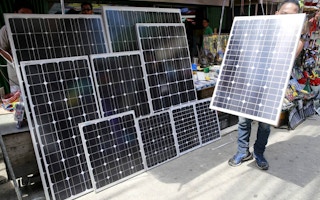The Philippines can save $200 million a year and build a more reliable energy supply for millions of residents on its small islands by replacing diesel generators with renewable sources such as wind and solar, said a report released on Monday.
The switch would require at least $1 billion in private investment in the short term, but the sum would be offset by savings of $200 million each year - an expense currently borne by users, the report said.
Many of the archipelago nation’s small islands cannot access larger electricity grids.
Mini-grids powered by generators that use imported diesel and oil serve approximately 800,000 households, but there are frequent blackouts, said the report by the US-based Institute for Energy Economics and Financial Analysis (IEEFA) and Manila-based Institute for Climate and Sustainable Cities (ICSC).
“
Renewable energy systems are not only sustainable but affordable and secure because there is no fuel requirements.
Sarah Ahmed, energy finance analyst and report main author, Institute for Energy Economics and Financial Analysis (IEEFA)
Less than 10 per cent of 233 small islands have 24-hour electricity, while more than 70 per cent have less than eight hours of electricity per day, according to the ICSC.
Modernising small island power systems with renewables will supply cheaper, efficient, secure, cleaner power, the report said.
“Renewable energy systems are not only sustainable but affordable and secure because there is no fuel requirements,” Sarah Ahmed, IEEFA’s energy finance analyst and the report’s main author, told the Thomson Reuters Foundation.
Since 2009, solar power costs have fallen by 90 per cent and that of wind power has fallen 50 per cent, the report said.
Yet many small islands in the Philippines have not turned to renewables due to a host of factors including outdated regulations, it said.
This includes a lack of incentives for island electric cooperatives - small, customer-owned utilities controlled by locally elected boards - to procure cheaper sources, and slow implementation of a 2008 law meant to promote the development of renewable energy, it added.
“Islands such as Sumba in Indonesia have already cut energy costs by 35 percent by following the global trend towards renewables,” Jose Logarta, ICSC senior energy advisor and co-author of the report, said in a statement.
Sumba, a mountainous island in eastern Indonesia, is using a combination of wind, solar and small-scale hydropower to achieve 95 percent renewable electricity for its 650,000 residents by 2025.
“This indicates a major opportunity for islands all across the Philippines,” Logarta said.
This story was published with permission from Thomson Reuters Foundation, the charitable arm of Thomson Reuters, that covers humanitarian news, women’s rights, corruption and climate change. Visit www.trust.org.
The Thomson Reuters Foundation is reporting on resilience as part of its work on zilient.org, an online platform building a global network of people interested in resilience, in partnership with the Rockefeller Foundation.










